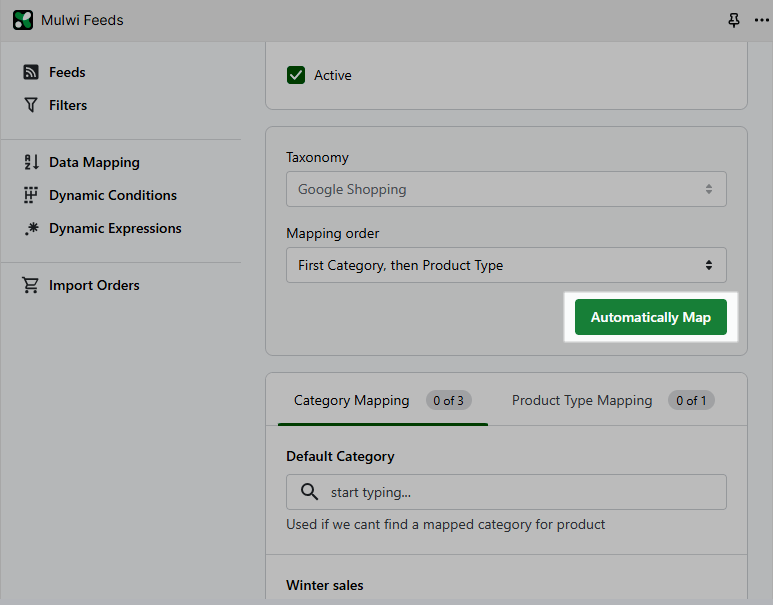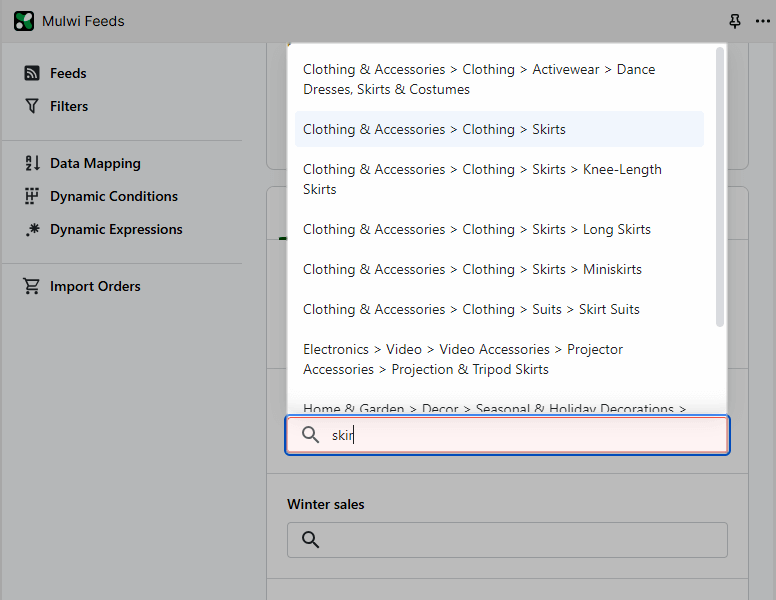Google Ads have a huge influence in the digital market, with 76.4% of all online commerce spending. It showcases the dominant role Google plays in the advertising landscape. If businesses use this powerful tool, they can maximize their outreach and profitability. The Google Shopping platform gets 85.3% of clicks on Adwords or campaign ads. This number shows the widespread engagement of users.
The competitiveness in Google Shopping advertising is high. That's why product data management, particularly Google's product categorization, is important. It has the potential to enhance the return on investment for advertising campaigns. Businesses can increase the visibility of their offerings and attract a larger audience. It can lead to improved conversion rates and increased revenue.

Google's Diverse Taxonomy
Google Shopping offers various categories that form a constantly evolving taxonomy to keep it comprehensive and relevant. With over 6,000 categories listed, sellers can find those that match their inventory. Here is the list of Google product categories to see how well it is structured.
Please note that the subdivision of Google product categories list is currently limited to twelve countries: the United Kingdom, France, Germany, Turkey, the United States, Sweden, Japan, Italy, Brazil, Australia, Norway, and the Netherlands. In countries outside this list, using a product type attribute is necessary for subdivision.
Product Category and Product Type in Google Shopping
In the world of online marketing, understanding your competitors and spending smartly is important. Organizing your products correctly on Google involves understanding the difference between Google Product Category and Product Type, ensuring Google matches your products with relevant user searches.
- A Google Product Category is an attribute helping you to categorize an item within the Google Shopping taxonomy. It is used by Google to identify goods and match them with shoppers' searches. Thus, this attribute can boost sellers’ sales.
- The Google Product Type serves as an optional attribute for informing Google about your product organization. It allows you to categorize your goods based on your own criteria if the existing Google category names do not align with your products or if your country is not listed. Google utilizes this information to align your items with relevant search queries from users.
In the context of Google Shopping, the primary objective is to display your product advertisements to the appropriate audience. Leveraging both Product Type and Google Shopping Category significantly enhances the likelihood of expanding your product's reach, enabling effective organization and delivering an exceptional online shopping experience for your customers.
The Significance of Google Categories for Your Store
Enhancing search engine visibility through SEO and leveraging well-chosen categories can optimize your return on advertising investment in Google Shopping. Let's explore what this means and how it operates.
SEO and Visibility in Google Shopping
SEO involves enhancing the visibility of your online content, such as your product listings, to boost your presence on search engines like Google. Properly categorized products are crucial for enhancing your SEO and making your products more visible to potential customers on Google Shopping.
Here's how it works:
- Effective categorization enhances search visibility: When you categorize your products correctly, Google can better understand what you're selling. For example, if you sell smartphones and you've properly categorized them under "Electronics" and "Mobile Phones," your products are more likely to show up when someone searches for "mobile phones" on Google Shopping.
- Improved user experience through subdivision: Customers searching for products appreciate organized and relevant search results. Proper categorization ensures that your products appear in the right context, making it easier for shoppers to find what they want. It increases the chances of a sale and provides a positive user experience, as customers can quickly locate the products they want.
Boosting Advertising ROI with Enhanced Categories
Enhancing Advertising ROI with Enhanced Categories refers to maximizing your advertising campaigns' return on investment (ROI) by effectively selecting and managing product categories in your Google Shopping or online store.
Here's how it works:
- Precise Targeting: Carefully selecting product categories ensures your ads reach the most suitable audience. For instance, if you're selling running shoes, placing them in the "Athletic Footwear" category instead of a generic "Footwear" category ensures users interested in athletic shoes see your ads. This precision in targeting increases the likelihood of reaching potential customers more likely to purchase.
- Cost Efficiency: Well-managed categories help allocate your advertising budget more efficiently. By targeting the right categories, you reduce the likelihood of wasted ad spending on irrelevant audiences. This cost-saving aspect directly contributes to an improved ROI because you spend your budget where it matters most.
- Increased Click-Through Rates (CTR): Ads that appear in the right categories are more likely to attract clicks from interested users. An optimized category placement ensures your products are seen by people actively searching for those items, leading to a higher CTR. A higher CTR leads to increased traffic for your store or website.
- Maximized Conversions: Effective category management can lead to higher conversion rates. When your products are shown to users genuinely interested in them, the chances of turning those users into customers are greater. As a result, you get more value from your advertising investments.
Understanding how Google Categories function and implementing them effectively in your store doesn't just improve your search engine visibility but also optimizes your ads, ensuring your products are seen by the right audience and leading to improved outcomes for your ad spending.
Aligning Shopify Collections with Google's Categories
A Shopify Collection is a group of products that sellers can create to ease the navigation of their stores. For instance, a seller can establish a collection dedicated to a particular product category they offer, like Shoes.
Using collections provides several benefits, including:
- Efficient product organization, enabling customers to find products more seamlessly.
- You can create collections for different product types, sizes, colors, or seasonal items, providing a more organized shopping experience.
- Additionally, collections allow you to make product recommendations on your store, helping customers discover related products.
- By incorporating links to the collections in your store's navigation menu, you can enhance customer navigation and exploration within your store.
Aligning the collections in your Shopify store with Google Shopping categories is essential to ensure accurate generation of your product feed. This is critical for the following reasons:
- Accurate data matching: Google Product Categories serve as a standardized taxonomy used by Google to classify different types of products. When you align your website collections with these categories, you show Google what each product is and where it belongs within its extensive taxonomy.
- Streamlined advertising: Accurate categorization can significantly impact your advertising efforts. Your Google Ads campaigns rely on properly categorized products to display relevant ads to potential customers. When products match the right categories, you improve the chances of reaching potential customers more likely to purchase.
Mulwi categories mapping for Google Shopping
The Mulwi data mapping ensures your product feed accurately aligns with Google's product categories, enhancing the visibility of your products. Our app provides a preconfigured Google Shopping feed. You can add it from the list of feeds in the app. More details on how to create a Google Shopping feed and connect it to the Google Merchant Center you can find here.
Go to the Product Category/Collection section in the General tab of your Google Shopping feed to accurately categorize your products. There are two options depending on your inventory categorization.
a) If your store collection(s) match only one Google category, select the Static value and start typing the category name. It will be autocomplete for all products. Press the Save button.
b) In case your store collections correspond to different Google Shopping categories, specify different categories for various product collections using the Data Mapping option:
- In the Data Mapping tab press Add Data Mapping button.
- Set the Name to distinguish this data mapping from other data mappings. Enter the Internal code (e.g. gs_mapping). You will need it to access this data mapping in the feed template. Select Google Shopping in the Taxonomy/Marketplace field to align your Shopify Collections with Google Categories. Press the Save button.
- Choose the preferred order of categorization: by category first or by product type first. This choice is essential for Mulwi to correctly map your items, as the names of product categories and product types may be the same.
You can map the categories in two ways:
Automated Category Mapping
With Mulwi, you can automatically assign the appropriate Google Product Categories to each product. This is especially time-saving for large inventories or frequently changing product types. Imagine managing an apparel store with seasonal items; your summer clothing will be accurately categorized without manual effort. The Mulwi app uses AI to align your categories with Google Shopping's product taxonomy.
- Click the Automatically Map button to map the categories.

Manual Category Mapping
At times, manual oversight is essential. You may have specialized or unique products that require precise categorization. Mulwi allows you to manually align categories to ensure the accuracy of your product feed.
- Start typing the category name in the Google product category finder and select the necessary Google category to align it with your collection.

Product Type Mapping
Utilizing Product Type Mapping is advised as it ensures precise product classification. While a product can be of only one type, it can belong to multiple categories. Mapping based only on categories might result in placing the product in an inappropriate category within the Google Shopping taxonomy.
Mulwi facilitates mapping based on "product type" . This feature provides an additional level of detail. For example, you have the option to classify a toy dinosaur figure under "Toys & Games > Dolls, Playsets & Toy Figures" in Google Shopping, guaranteeing its accurate placement within the classification system.
Conclusion
The significance of Google Product Categories cannot be overstated in the realm of e-commerce. They serve as the backbone for effective product visibility, customer engagement, and overall success in online selling. The proper alignment of product categories with Google's taxonomy is crucial for maximizing reach and ensuring a seamless user experience.
Mulwi's Google Shopping feed facilitates efficient product categorization through both automated and manual mapping options, ensuring accurate alignment with Google's product categories. While automated categorization saves time and streamlines the process, it necessitates cautious oversight to prevent potential errors in categorization.
More information on Mulwi data mapping you can find here.




